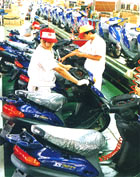





| China's Agriculture & Rural Economy See All-round Development |
|
During the ninth Five-Year Plan period, the Party and the government further stabilized and improved various rural policies, unceasingly deepened the rural reform, increased investment in agricultural infrastructure construction on an annual basis, and vigorously promoted the strategic readjustment of agricultural structure. Implementation of all these measures in the first four years shows that the agricultural production has maintained a sustained growth and the supply-demand situation of agricultural products has improved fundamentally. The readjustment of agricultural structure has taken a new step forward and non-agricultural production in the countryside has experienced constant development. The income of farmers has somewhat increased with further improvement in the quality of their lives. The rural economy has developed in an all-round way. In the first four years of the ninth Five-Year Plan period, of the GDP, the average annual added value of the primary industry came to 1420. 5 billion yuan, that in 1999 to 1421.2 billion yuan. Calculated on the basis of comparable price, in the first four years of the ninth Five-Year Plan period, the average annual growth of agricultural added value was 4.3 percent, basically equaling the figure of 4.2 percent in the eighth Five-Year Plan period. Fairly good harvests of grain and other stable crops have been gathered in for years on a row. The output of grain increased from 466.62 million tons in 1995 to 508.39 million tons in1999, meeting the target set in the ninth Five-Year Plan ahead of time. The average annual output of cotton in the first four years of the ninth Five-Year Plan period hit 4.28 million tons, and that of oil-bearing crop, sugar crop, meat and aquatic products in the same period reached 23.2 million tons, 89.68 million tons, 53.53 million tons and 37.3 million tons respectively. Presently, China's output of grain, cotton, rapeseed, tobacco, meat, eggs, aquatic products and vegetables all rank first in the world. Since the launch of the ninth Five-Year Plan in 1996, China has actively adapted its agriculture to changes in market demand and further optimized its agricultural structure. The proportion of the area sown to grain to the total crop area has decreased from 73.4 percent in 1995, the end of eighth Five-Year Plan period, to 72.4 percent in 1999. The area planted to cash crop and feed crop has expanded notably. The proportion of herbivorous livestock and poultry has continued to rise. The proportion of pork to the total output of meat has sunk from 68.7 percent in 1995 to 67.2 percent in 1999. The proportion of agriculture to the gross output value of farming, forestry, animal husbandry and fishery has shrunk from 58.4 percent in 1995 to 57.5 percent in 1999. The proportion of forestry, animal husbandry and fishery increased from 41.6 percent to 42.5 percent. Township enterprises have maintained the rapid growth momentum. In 1999, the country's township enterprise employees numbered 123 million, a slight decrease from 1995, bringing about an added value of 2,530 billion yuan. Calculated on the basis of comparable price, the average annual growth in the first four years of the ninth Five-Year Plan period jumped by over 12 percent, township enterprises' added value accounted for more than 30 percent of the GDP. At the same time, township enterprises have become an important part of China's foreign trade, the delivery exports value has taken up about one-third of the nation's total export value. Small towns have entered the stage of rapid development. Currently,
there are 19,000 organic towns nationwide. When rural towns are
added, the total number of China's small towns reaches 45,000. The
resident population of small towns exceeds 160 million. (People's Daily 09/21/2000) |
